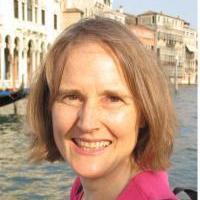Books by Vannina Marchi van Cauwelaert

Global History is all the rage. This is uncongenial to some, who wish to defend the national iden... more Global History is all the rage. This is uncongenial to some, who wish to defend the national identity of a France limited within the borders of what today is called France. Essentially, they look to “Christianity” for hypothetical historical roots. Others make of it a new sphere of reflection, where they play with unconvincing comparisons and unsubstantiated connexions.
French historians, and perhaps more especially the medieval specialists have been reluctant to take up themes derived from the Anglo-Saxon world and from newly emerging countries. This could be because they still consider themselves heirs to the work of Fernand Braudel, even if he is out of date and the subject of contestation. Another reason could be the watertight separation between European and Mediterranean History, mainly studied within the university context and the history of more faraway places that has its home in different institutions.
Nevertheless, it is clear that in Medieval Times, the different worlds were deeply connected, even over very long distances. Long before the Age of Discovery and the Modern Period, men and women would travel and exchange, often going to faraway places. It, therefore, behoves the community of Medieval Specialists to examen the ways and means of these connections, not in order to posit the existence of some premature version of the “global village” or to deny the existence of spaces and worlds that have their own internal coherence at a particular point in time, but rather to think about the epistemological conditions of such an approach.
On what scale must we think about historical phenomena? It is this question, central to our research work, that is posed by the 47th Congress of the SHMESP.
The papers found in this volume look towards wide horizons, towards Central Asia and the Far East, towards Sub-Saharan Africa and the Pacific Ocean. They do not, however, leave out the European and Mediterranean spaces with which we can be expected to be more familiar. Here they search for connections and find sources for striking comparisons.
Thus, the reader of this volume will have access to a global, connected History of the Middle Ages, which is open to the world. It bears witness to the vitality and diversity of French research and once again seeks to answer the ever-recurring question of the “roots” of our contemporary worlds.

Al insegna del giglio, 2020
Vannina Marchi * 9. Les lieux de pouvoir génois en Corse : Diffusion d'un modèle urbanistique com... more Vannina Marchi * 9. Les lieux de pouvoir génois en Corse : Diffusion d'un modèle urbanistique communal en milieu colonial (XIII e-XV e siècles) ** Dans le cadre de cette réflexion collective sur les palais publics à l'époque communale et face aux autres exemples italiens et méditerranéens présentés dans cet ouvrage, la Corse génoise fait figure de parent pauvre. Le caractère très fragmentaire des archives à notre disposition, la médiocrité des édifices conservés ainsi que la rareté des études archéologiques rendent en effet particulièrement difficile l'appréhension de ce qu'a pu être l'édilité communale génoise en Corse. Si l'empreinte de Gênes est encore visible dans la diffusion du fait urbain sur le littoral, à Bonifacio et Calvi au XIII e siècle, à Bastia, Ajaccio, Algajola et Saint-Florent au XV e siècle, la réalité matérielle de ces villes continue de nous échapper 1. De fait, si l'on excepte le cas de Bonifacio, qui se distingue à la fois par l'existence d'un important corpus d'actes notariés 2 et par la préservation d'une architecture médiévale particulièrement riche à l'échelle de l'île 3 , l'on ne sait à peu près rien de l'urbanisme génois en Corse avant l'extrême fin du XV e siècle. À cette époque, le passage de l'île sous l'autorité de l'Office de Saint-Georges, qui gouverne la Corse au nom de la Commune, se traduit à la fois par l'émergence d'une administration centralisée qui entraîne une augmentation des archives, et par une politique d'urbanisation du littoral qui engendre une multiplication des chantiers 4. Siège du gouverneur, la ville de Bastia devient capitale de l'île tandis que dans le Sud, la victoire contre les seigneurs permet l'édification d' Ajaccio, où le pouvoir du gouverneur est relayé par un lieutenant 5. Dans le même temps, l'Office de Saint-Georges procède à la rénovation des anciens sièges du pouvoir génois, Bonifacio et Calvi, notamment en vue d'adapter leurs fortifications au développement de l'artillerie lourde 6. Dans les années 1530, l'humaniste Agostino Giustiniani, titulaire de l'évêché corse du Nebbio, livre une description de l'île qui dresse un portrait en demi-teinte de cette action édilitaire. Évoquant le site de Calvi, l'évêque souligne la « bellezza di edifici », mais il précise « secondo che comporta il paese ». À Bastia, l'humaniste décrit de « belle case edificate al modo di Genua » et admet que le palais des gouverneurs, récemment construit par l'Office, « non si può negare che non sia una bella cosa », mais il ajoute que le résultat n'est pas à la hauteur des 25000 ducats déboursés 7. * Université de Corse-LISA UMR6240. *Nous remercions Jean-André Cancellieri pour l'aide qu'il nous a apportée lors de la rédaction de cet article et notamment pour ses très précieuses indications documentaires.
I palazzi comunali costituiscono una delle impronte più significative lasciate dai grandi comuni ... more I palazzi comunali costituiscono una delle impronte più significative lasciate dai grandi comuni cittadini, soprattutto in Lombardia, Emilia e Toscana. Con tratti tipologici ben riconoscibili (per esempio il grande spazio aperto al pianterreno oppure la torre) hanno avuto un impatto monumentale sui centri delle città comunali, oggetto di rinnovamenti e restauri nel corso dei secoli. Ma cosa succede in quelle aree dove i comuni ebbero una vita più discontinua? Esistono i palazzi comunali ai margini del mondo comunale e, se sì, quali forme assumono? Questo è il tema di ricerca affrontato dal volume, che offre uno sguardo ampio sui palazzi comunali nel mondo mediterraneo, dalle Alpi, all’Italia meridionale, fino alla Croazia, alla Corsica e alla Provenza.
Papers by Vannina Marchi van Cauwelaert

Dans la continuité d'un précédent atelier qui avait été consacré aux « villes portuaires ... more Dans la continuité d'un précédent atelier qui avait été consacré aux « villes portuaires de Méditerranée occidentale au Moyen Âge. Îles et continents » (juin 2013), cette rencontre se propose de poursuivre la réflexion sur les îles, en élargissant l'horizon à l'ensemble de l'espace méditerranéen, et en s'intéressant plus particulièrement aux aspects géostratégiques et économiques liés à l'insularité. En réunissant des spécialistes français, espagnols et italiens, l'enjeu de cet atelier est de s'interroger sur le caractère opératoire du concept d'insularité pour étudier la Méditerranée médiévale. Si l'étude des îles méditerranéennes à l'époque antique a connu de profonds renouvellements ces dernières années, notamment sous l'impulsion des travaux de N. Purcell et de P. Horden (The Corrupting Sea…), il n'existe pas à ce jour d'étude globale sur la question pour l'époque médiévale. Or une approche globale de la notion d'insularité au Moyen Âge permettrait de décloisonner les études insulaires, qui sont le plus souvent menées dans un cadre historiographique national – voire parfois régional-ce qui limite les possibilités de comparaison et de synthèse. En dépit du rayonnement de certains travaux, notamment sur la Sicile, force est de constater que les îles demeurent le parent pauvre de l'historiographie méditerranéenne. Fondée sur l'idée que l'insularité pourrait être au contraire une clé de lecture fructueuse, l'organisation de cette rencontre vise à mettre en place un projet de recherche européen (France, Espagne, Italie) dont l'objectif ultime serait d'écrire une « histoire insulaire de la Méditerranée médiévale ».

A la fin du XVe siecle, la domination de l’Office de San Giorgio en Corse se traduit par un mouve... more A la fin du XVe siecle, la domination de l’Office de San Giorgio en Corse se traduit par un mouvement d’urbanisation de l’ile : Bastia, fondee en 1476, est erigee en capitale, tandis qu’une nouvelle ville est creee dans le Sud en 1492 : Ajaccio. Dans le meme temps, les anciens centres urbains (Calvi et Bonifacio) sont renoves. Sous le gouvernement de San Giorgio, le territoire insulaire est donc reorganise selon la dialectique «ville-campagne» . Dans les campagnes, cette reorganisation se traduit par de grands mouvements de disabitazione qui frappent des regions entieres. Bien que l’urbanisation et les disabitazioni relevent de la meme strategie territoriale, une analyse approfondie des sources revele que les depeuplements, en contraignant les Corses a renouer avec des pratiques de nomadisme abandonnees depuis plus d’un siecle, allaient a l’encontre du projet genois. Cet aspect de la domination de San Giorgio temoigne donc de la force des representations relatives a la Corse dans la politique territoriale genoise.
HAL (Le Centre pour la Communication Scientifique Directe), 2020
HAL (Le Centre pour la Communication Scientifique Directe), Oct 20, 2015
HAL (Le Centre pour la Communication Scientifique Directe), Oct 20, 2015
CNRS Éditions eBooks, 2016
HAL (Le Centre pour la Communication Scientifique Directe), Jul 24, 2014
La ville coloniale génoise des temps médiévaux en Corse peut être définie, avec de nécessaires nu... more La ville coloniale génoise des temps médiévaux en Corse peut être définie, avec de nécessaires nuances, comme une greffe stratégique, démographique et économique sur le liséré côtier, en position de frontière et d’échanges limités mais réels avec l’hinterland insulaire. Sous cet aspect, la région géographique de la Balagne, entendue des Agriates au Sia, ne connaît d’histoire citadine, avec Calvi, sa première et principale création proto-urbaine allogène (sur le modèle partiel du Bonifacio gén..
HAL (Le Centre pour la Communication Scientifique Directe), Nov 8, 2018
HAL (Le Centre pour la Communication Scientifique Directe), Oct 17, 2018
Les îles méditerranéennes au Moyen Âge. Enjeux stratégiques et ressources économiques, Nov 24, 2016











Uploads
Books by Vannina Marchi van Cauwelaert
French historians, and perhaps more especially the medieval specialists have been reluctant to take up themes derived from the Anglo-Saxon world and from newly emerging countries. This could be because they still consider themselves heirs to the work of Fernand Braudel, even if he is out of date and the subject of contestation. Another reason could be the watertight separation between European and Mediterranean History, mainly studied within the university context and the history of more faraway places that has its home in different institutions.
Nevertheless, it is clear that in Medieval Times, the different worlds were deeply connected, even over very long distances. Long before the Age of Discovery and the Modern Period, men and women would travel and exchange, often going to faraway places. It, therefore, behoves the community of Medieval Specialists to examen the ways and means of these connections, not in order to posit the existence of some premature version of the “global village” or to deny the existence of spaces and worlds that have their own internal coherence at a particular point in time, but rather to think about the epistemological conditions of such an approach.
On what scale must we think about historical phenomena? It is this question, central to our research work, that is posed by the 47th Congress of the SHMESP.
The papers found in this volume look towards wide horizons, towards Central Asia and the Far East, towards Sub-Saharan Africa and the Pacific Ocean. They do not, however, leave out the European and Mediterranean spaces with which we can be expected to be more familiar. Here they search for connections and find sources for striking comparisons.
Thus, the reader of this volume will have access to a global, connected History of the Middle Ages, which is open to the world. It bears witness to the vitality and diversity of French research and once again seeks to answer the ever-recurring question of the “roots” of our contemporary worlds.
Papers by Vannina Marchi van Cauwelaert
French historians, and perhaps more especially the medieval specialists have been reluctant to take up themes derived from the Anglo-Saxon world and from newly emerging countries. This could be because they still consider themselves heirs to the work of Fernand Braudel, even if he is out of date and the subject of contestation. Another reason could be the watertight separation between European and Mediterranean History, mainly studied within the university context and the history of more faraway places that has its home in different institutions.
Nevertheless, it is clear that in Medieval Times, the different worlds were deeply connected, even over very long distances. Long before the Age of Discovery and the Modern Period, men and women would travel and exchange, often going to faraway places. It, therefore, behoves the community of Medieval Specialists to examen the ways and means of these connections, not in order to posit the existence of some premature version of the “global village” or to deny the existence of spaces and worlds that have their own internal coherence at a particular point in time, but rather to think about the epistemological conditions of such an approach.
On what scale must we think about historical phenomena? It is this question, central to our research work, that is posed by the 47th Congress of the SHMESP.
The papers found in this volume look towards wide horizons, towards Central Asia and the Far East, towards Sub-Saharan Africa and the Pacific Ocean. They do not, however, leave out the European and Mediterranean spaces with which we can be expected to be more familiar. Here they search for connections and find sources for striking comparisons.
Thus, the reader of this volume will have access to a global, connected History of the Middle Ages, which is open to the world. It bears witness to the vitality and diversity of French research and once again seeks to answer the ever-recurring question of the “roots” of our contemporary worlds.